 The latest preliminary GDP estimates for 2014 Q1 suggest that the economy’s output (real GDP) expanded by 0.8 per cent following on the back of a 0.7 per cent increase in 2013 Q4. Growth was observed in three of the four main industrial sectors: 0.9% in services, 0.8% in production and 0.3% in construction. In contrast, output decreased by 0.7% in agriculture. The total output of the economy is now just 0.6 per cent below its 2008 Q1 peak with the output of the service sector now 2.0 per cent higher.
The latest preliminary GDP estimates for 2014 Q1 suggest that the economy’s output (real GDP) expanded by 0.8 per cent following on the back of a 0.7 per cent increase in 2013 Q4. Growth was observed in three of the four main industrial sectors: 0.9% in services, 0.8% in production and 0.3% in construction. In contrast, output decreased by 0.7% in agriculture. The total output of the economy is now just 0.6 per cent below its 2008 Q1 peak with the output of the service sector now 2.0 per cent higher.
Data on growth need to be set in the context of the inherent volatility of economies and in this case in the context of 2008/9 recession. Then, output fall by some 7.2 per cent. UK output peaked in 2008 Q1 (£392.786 billion at 2010 prices). There then followed 6 quarters during which output declined.
Output declined again in 2010 Q4 (-0.2% growth), in 2011 Q4 (-0.1% growth), in 2012 Q2 (-0.4%) and in 2012 Q4 (-0.2%). A double-dip recession was only narrowly avoided with growth recorded at zero on 2012 Q1. The latest ONS numbers show the economy grew by 0.8 per cent in 2013 Q2 (to £381.318 billion at 2010 prices), by 0.8 per cent in 2013 Q3 (to £384.533 billion at 2010 prices), by 0.7 per cent in 2013 Q4 (to £387.138 billion at 2010 prices) and by 0.8 per cent in 2014 Q1 (to £390.235 billion at 2010 prices). Compared with 2013 Q1, the output of the UK economy in 2014 Q1 is 3.1 per cent higher.
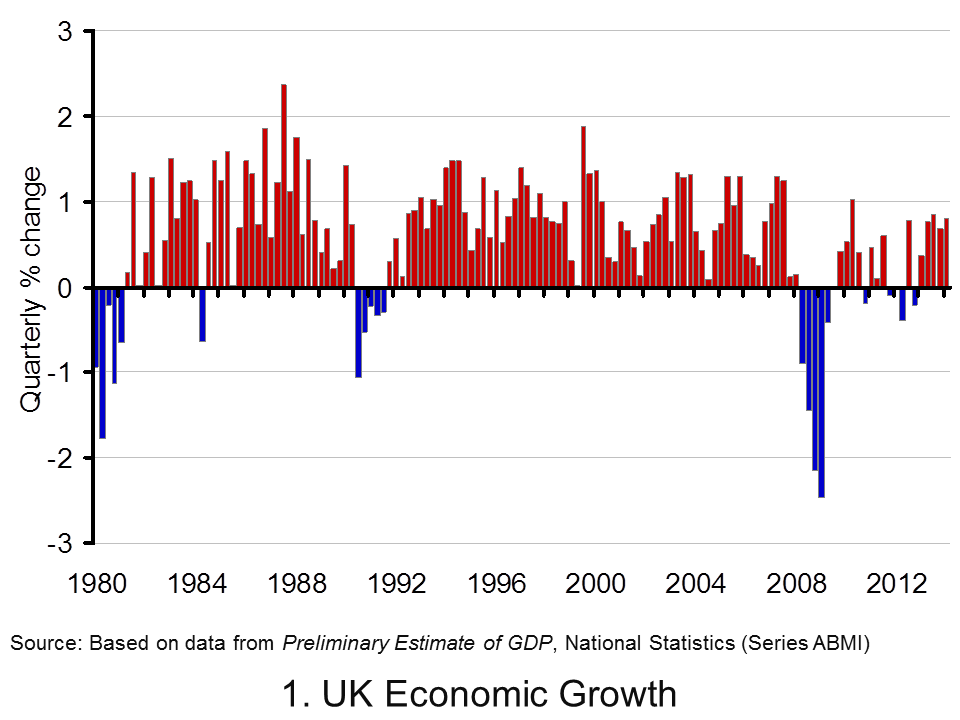 Chart 1 helps to put the recent growth numbers into an historical context. It shows the quarterly change in real GDP since the 1980s. We can see the 5-quarter recession that commenced in 1980 Q1 when output shrunk by 4.6 per cent, the 5-quarter recession that commenced in 1990 Q3 when output shrank by 2.4 per cent and the 6-quarter recession that commenced in 2008 Q2 when output shrank by 7.2 per cent. (Click here to download the chart to PowerPoint.)
Chart 1 helps to put the recent growth numbers into an historical context. It shows the quarterly change in real GDP since the 1980s. We can see the 5-quarter recession that commenced in 1980 Q1 when output shrunk by 4.6 per cent, the 5-quarter recession that commenced in 1990 Q3 when output shrank by 2.4 per cent and the 6-quarter recession that commenced in 2008 Q2 when output shrank by 7.2 per cent. (Click here to download the chart to PowerPoint.)
 Chart 2 scratches a little below the surface by looking at output by the 4 principal industrial types. The interesting finding is that the output of the service sector has now risen above its 2008 Q1 peak. In 2014 Q1, service sector output was 2.0 per cent higher than 2008 Q1. The fact that total output remains 0.6 per cent lower can be explained by the lop-sided industrial recovery. Output in agriculture, forestry and fisheries remains 7.1 per cent lower, production (including manufacturing) 11.5 per cent lower and construction 12.2 per cent lower. (Click here to dowload the chart to Powerpoint.)
Chart 2 scratches a little below the surface by looking at output by the 4 principal industrial types. The interesting finding is that the output of the service sector has now risen above its 2008 Q1 peak. In 2014 Q1, service sector output was 2.0 per cent higher than 2008 Q1. The fact that total output remains 0.6 per cent lower can be explained by the lop-sided industrial recovery. Output in agriculture, forestry and fisheries remains 7.1 per cent lower, production (including manufacturing) 11.5 per cent lower and construction 12.2 per cent lower. (Click here to dowload the chart to Powerpoint.)
Data
Preliminary Estimate of GDP – Time Series Dataset Q1 2014 Office for National StatisticsGross Domestic Product Preliminary Estimate, Q1 2014 Office for National Statistics
Articles
UK GDP ‘close to pre-crisis level’ says NIESR BBC News (9/5/14)
UK ‘great recession’ almost over, says thinktank Guardian, Katie Allen (9/5/14)
UK economy tops its pre-crash high point, says NIESR Telegraph, Szu Ping Chan (9/5/14)
UK economy grew by 0.8% in first three months of 2014 Guardian, Katie Allen and Angela Monaghan (29/4/14)
Manufacturing is GDP star performer BBC News, Robert Peston (29/4/14).
Questions
- What is the difference between nominal and real GDP? Which of these helps to track changes in economic output?
- Looking at Chart 1 above, summarise the key patterns in real GDP since the 1980s.
- What is a recession? What is a double-dip recession?
- What are some of the problems with the traditional definition of a recession?
- Can a recession occur if nominal GDP is actually rising? Explain your answer.
- What factors lead to economic growth being so variable?
- What factors might explain the very different patterns seen since the late 2000s in the volume of output of the 4 main industrial sectors?
- Produce a short briefing paper exploring the prospects for economic growth in the UK over the next 12 to 18 months.
- Explain the arguments for and against using GDP as a measure of a country’s economic well-being.
- Analyse the role that the financial system might play in contributing to or alleviating the business cycle.
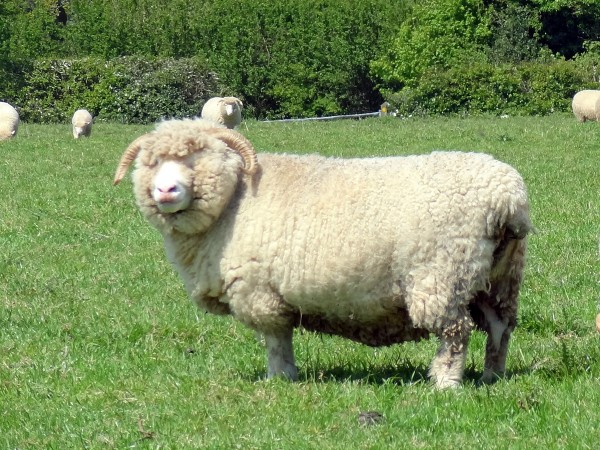 The European Parliament, Council and Commission have agreed on reform to the Common Agricultural Policy as part of the EU’s long-term budget settlement for 2014–20. The CAP accounts for some 38% of the EU’s budget and, over the years, has drawn considerable criticism for resulting in food mountains and support being biased towards large intensive farms.
The European Parliament, Council and Commission have agreed on reform to the Common Agricultural Policy as part of the EU’s long-term budget settlement for 2014–20. The CAP accounts for some 38% of the EU’s budget and, over the years, has drawn considerable criticism for resulting in food mountains and support being biased towards large intensive farms.
As section 3.5 in Economics (8th ed) explains, the CAP has been through a number of reforms since the early 1990s. Prior to that, the main form of support was that of guaranteed minimum prices backed up, where necessary, by levies (tariffs) on imported food. Any surplus of production at the minimum price was bought by the relevant EU Intervention Board and either stored or exported at world prices. The effect of minimum prices is shown in the diagram.
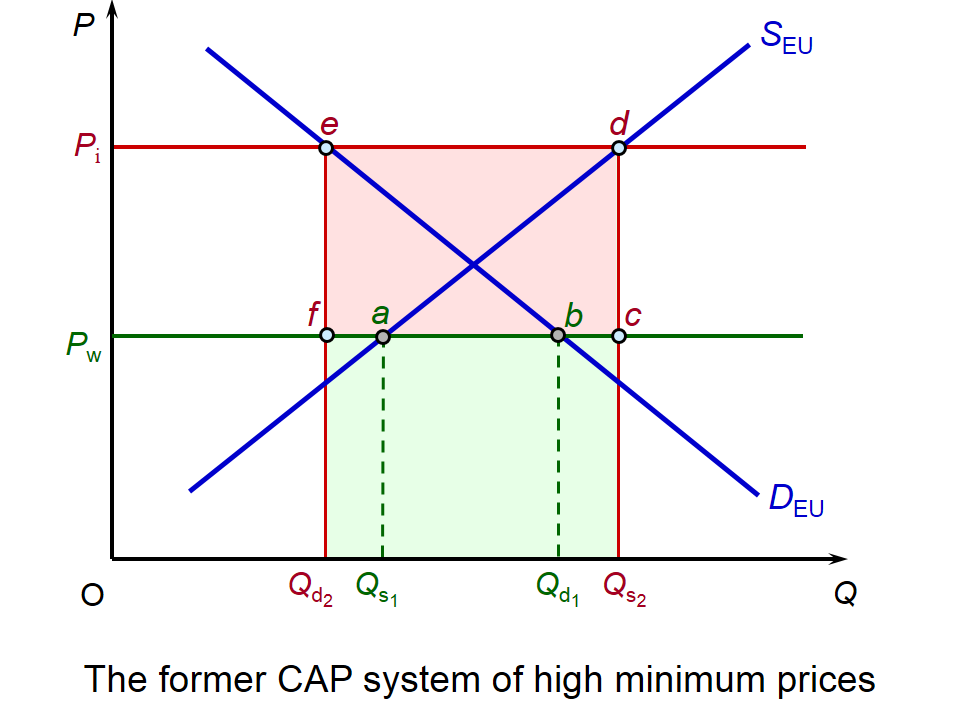 Assume that the EU demand is DEU and that EU supply is SEU. Assume also that the world price is Pw. This will be the equilibrium price, since any shortage at Pw (i.e. b – a) will be imported at that price. Thus before intervention, EU demand is Qd1 and EU supply is Qs1 and imports are Qd1 – Qs1.
Assume that the EU demand is DEU and that EU supply is SEU. Assume also that the world price is Pw. This will be the equilibrium price, since any shortage at Pw (i.e. b – a) will be imported at that price. Thus before intervention, EU demand is Qd1 and EU supply is Qs1 and imports are Qd1 – Qs1.
Now assume that the EU sets an intervention price of Pi. At this high price, there will be a surplus of d – e (i.e. Qs2 – Qd2). Assume for the moment that none of this surplus is exported. It will all, therefore, be bought by the appropriate Intervention Board. The cost to the EU of buying this surplus is shown by the total shaded area (edQs2Qd2: i.e. the surplus multiplied by the intervention price). Unless the food is thrown away, exported or otherwise disposed of, there will obviously then be the additional costs of storing this food: costs that were very high in some years as wine ‘lakes’ and grain and dairy ‘mountains’ built up. If, however, the surplus is sold on world markets at the world price Pw, this will earn the green area for the EU, leaving a net cost of just the pink area.
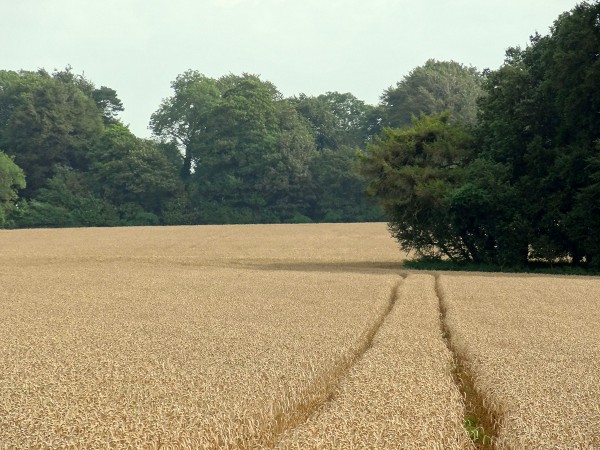 From 1992, there was a gradual move towards lowering intervention prices and paying farmers direct aid unrelated to current output. From 2004, the main form of support became these direct aid payments. Annual payments to each farm were based on the average support it had received over the three years from 2000 to 2002. At the same time, payments to large farms were gradually reduced, with 80 per cent of the money saved in each country being diverted to rural development. Payments were also made conditional on farmers making environmental improvements to their land.
From 1992, there was a gradual move towards lowering intervention prices and paying farmers direct aid unrelated to current output. From 2004, the main form of support became these direct aid payments. Annual payments to each farm were based on the average support it had received over the three years from 2000 to 2002. At the same time, payments to large farms were gradually reduced, with 80 per cent of the money saved in each country being diverted to rural development. Payments were also made conditional on farmers making environmental improvements to their land.
A problem with this system is that farmers who had high average output in the years 2000–2 have been receiving the same large payments ever since, while farmers who had small yields in those years have received correspondingly small payments.
A proposal two years ago by Dacian Cioloş, the EU Commissioner for Agriculture, was for flat-rate payments per hectare. But objections were raised that this would benefit inefficient farmers who would receive the same as efficient ones. In the end a compromise agreement was reached which saw a capping of the amount of payment per hectare. The result is that the most intensive farmers will see a reduction in their payments by some 30% – a process that will happen gradually over the period 2014–19.
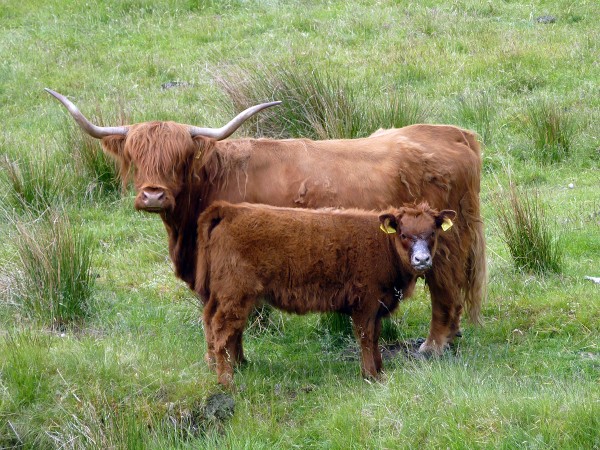 In addition it has been agreed that 30% of the direct aid payments will be conditional on farmers adopting various measures to protect the environment and wildlife.
In addition it has been agreed that 30% of the direct aid payments will be conditional on farmers adopting various measures to protect the environment and wildlife.
Farmers will have to be ‘active’ producers to receive direct aid payments. This is designed to exclude businesses such as airports or sports clubs, some of which had been receiving support under the previous system.
It was also agreed to provide 25% extra support for five years to farmers under 35 in an attempt to attract more young farmers into agriculture. Other details of the settlement are given in the EU documents, videos and articles below.
Webcasts
 The great shake-up of the Common Agricultural Policy EPP Group in the European Parliament (25/1/13)
The great shake-up of the Common Agricultural Policy EPP Group in the European Parliament (25/1/13)
 Planned reforms of Common Agricultural Policy under fire BBC News, Roger Harrabin (24/6/13)
Planned reforms of Common Agricultural Policy under fire BBC News, Roger Harrabin (24/6/13)
 Mixed response to compromise CAP deal RTE News (26/6/13)
Mixed response to compromise CAP deal RTE News (26/6/13)
 Farm reforms may not increase food production, warns MEP europeandyou, Diane Dodds MEP (26/6/13)
Farm reforms may not increase food production, warns MEP europeandyou, Diane Dodds MEP (26/6/13)
Articles
Big farms to see European subsidies slashed The Telegraph, Rowena Mason (26/6/13)
Common Agricultural Policy deal agreed at last RTE News, Damien O’Reilly (26/6/13)
CAP Reform: MEPs, Council and Commission strike deal FarmingUK (27/6/13)
EU agricultural overhaul puts onus on farmers to be green Financial Times, Joshua Chaffin (26/6/13)
CAP reform deal agreed in Brussels Farmers Guardian, Alistair Driver (26/6/13)
‘Bad for farmers and wildlife’ – CAP reform reaction Farmers Guardian, Alistair Driver (27/6/13)
EU documents
Political agreement on new direction for common agricultural policy Europa Press Release (26/6/13)
CAP Reform – an explanation of the main elements Europa Press Release (26/6/13)
Press release, 3249th Council meeting : Agriculture and Fisheries The Council of the European Union (25/6/13)
Questions
- Why will a system of agricultural support based solely on direct aid not result in any food mountains?
- Show in a diagram the effect of high minimum prices (plus import levies) on an agricultural product in which a country is not self-sufficient (and is still not made so by the high minimum price). How much will be imported before and after the intervention?
- What are the arguments for and against making direct aid payments based solely per hectare?
- Find out how sugar quotas have worked. What will be the effects of abolishing them by 2017?
- What ‘green’ measures are included in the agreement and how effective are they likely to be?
- Consider the arguments for and against removing all forms of support for agriculture in the EU.
- What are the effects of (a) price support and (b) direct aid payments unrelated to output for EU farmers on farmers in developing countries producing agricultural products in competition with those produced in the EU?
- Why may the environmental measures in the new agreement be seen as too weak?
The total EU budget in 2010 was €123 billion. Just under half of this (€58 billion) was spent on supporting agriculture. The programme of support – the Common Agricultural Policy (CAP) – has changed over the years. For a start, despite its being a large proportion of the EU budget, this proportion has actually been falling. In 1980, the CAP accounted for 69% of the EU budget; in 1990 it was 60%; in 2000 it was 52%; in 2010 it was 47%.
The types of support have also changed. The main method in the past was effectively to set minimum prices for various foodstuffs and for Intervention Boards to buy up any surpluses that arose from such prices being above the market equilibrium. Massive food ‘mountains’ resulted. Sometimes these surpluses were dumped on the world market; sometimes they were thrown away; sometimes they were simply kept in storage. Export subsidies and import levies (taxes) were also used to reduce surpluses. This, of course, was highly damaging to farmers in many countries outside the EU, especially in various primary exporting developing countries.
Reforms have taken place in recent years. The most important has been to replace high intervention prices with direct payments to farmers unrelated to current output. Whilst such payments still provide a substantial outgoing from the EU budget, being unrelated to current output, they do not encourage farmers to produce more and thus do not generate surpluses. Prices in most cases are allowed to be determined by the market.
The EU has just announced further reforms. These include:
• Capping total CAP spending at current levels until 2020
• Capping the total payment to any one farm to €300,000
• Relating subsidies to acreage rather than previous output
• Making 30% of the direct payments dependent on farmers meeting environmental criteria.
The following videos and articles examine the proposals and assess their likely benefits, their likely drawbacks and their likelihood of being implemented.
Videos
 EU plans to reform Common Agricultural Policy for farmers BBC News, Jeremy Cooke (12/10/11)
EU plans to reform Common Agricultural Policy for farmers BBC News, Jeremy Cooke (12/10/11)
 EU unveils controversial agricultural reforms Euronews (12/10/11)
EU unveils controversial agricultural reforms Euronews (12/10/11)
 Towards a new Common Agricultural Policy Euronews (14/10/11)
Towards a new Common Agricultural Policy Euronews (14/10/11)
 Queen to lose out in shake up of Europe’s farm payments Channel 4 News (12/10/11)
Queen to lose out in shake up of Europe’s farm payments Channel 4 News (12/10/11)
 Cautious welcome for EU agriculture policy shake-up STV News (12/10/11)
Cautious welcome for EU agriculture policy shake-up STV News (12/10/11)
 CAP reform proposals YouTube, Dacian Cioloş, European Commissioner for Agriculture and Rural Development (in French with English subtitles) (12/10/11)
CAP reform proposals YouTube, Dacian Cioloş, European Commissioner for Agriculture and Rural Development (in French with English subtitles) (12/10/11)
Articles
EU farm chief: CAP plans represent profound reform Reuters, Charlie Dunmore (12/10/11)
UK to dismiss Common Agricultural Policy reforms as inadequate Guardian, David Gow (11/10/11)
EU Farm Policy Debate Pits Top Receiver France Against U.K. Bloomberg Businessweek, Rudy Ruitenberg (12/10/11)
EU plans CAP reforms for ‘greener’ farm subsidies BBC News (12/10/11)
Common Agriculture Policy farm subsidy plan unveiled BBC News (12/10/11)
Q&A: Reform of EU farm policy BBC News (12/10/11)
CAP reform: Shepherd and steward of the land BBC News, Jeremy Cooke (12/10/11)
EU agriculture policy ‘still hurting farmers in developing countries’ Guardian: Poverty Matters blog, Mark Tran (11/10/11)
EU aid to farmers to continue over next decade Financial Times, Joshua Chaffin (12/10/11)
EU publications
CAP Reform – an explanation of the main elements Europa Press Release (12/10/11)
The European Commission proposes a new partnership between Europe and the farmers European Commission Press Release (12/10/11)
EU farm policy after 2013: Commission proposals welcomed with reservations European Parliament Press Release (12/10/11)
Legal proposals for the CAP after 2013 European Commission: Agriculture and Rural Development (12/10/11)
Questions
- Explain why the old system of price support under the CAP led to food surpluses. Use a diagram to illustrate your analysis.
- What is the significance of price elasticity of demand and supply in determining the size of these surpluses?
- What reforms have been introduced to the CAP in recent years? What effects have these had?
- Explain the new proposals for the CAP after 2013.
- What are the likely benefits of these proposals?
- What are the likely drawbacks of the proposals?
The outbreak of E. Coli has already cost lives, but it is also costing livelihoods of farmers who rely on producing and selling agricultural produce. Immediately following the outbreak in Germany, the blame was put on Spanish producers of cucumbers, which lead to the destruction of tens of thousands of kilos of fresh produce, costing Spain an estimated £177m per week in sales. Although Spain is not the source of the outbreak, the problem has not disappeared and will now affect the whole of Europe: at least until the source is identified. Countries such as Spain, France and Germany are big exporters to Russia and these countries are likely to take a big hit with the Russian health service banning imports of EU vegetables. The impact of this action (together with other countries implementing similar strategies) has not only affected agricultural producers, but is also having wider impacts on other sectors, including transportation. If no-one wants to buy the products, there’s very little use for the companies and indeed drivers to deliver them.
The Spanish economy will be looking for compensation from Germany for the losses they incurred, when sales of fruit and vegetables practically ceased following Germany’s initial accusation. As the Spanish Prime Minister Zapatero said:
“We acted as we had to, and we are going to get reparations and the return of Spanish products to their rightful place. … I believe that any other interpretation or any effort to politicise the huge mistake made by the German authorities is totally unfair.”
The effects of this outbreak have spread to UK supermarkets and producers. The former have reported a slight drop in sales of fruit and vegetables, but have not taken this opportunity to drop the prices paid to British growers, which is particularly important for cucumber producers, given the high production costs. Sarah Pettitt of the National Farmers Union said she was ‘extremely encouraged to hear that the major supermarkets … are not using this unfortunate situation as an excuse to drop prices to British growers.’ In fact some believe that the outbreak could be good for UK producers, as consumers increasingly turn to home-produced products. While the source of the outbreak remains unknown, so does the future of agricultural producers throughout Europe, as well as all those that have any dependence on this huge industry.
E. Coli outbreak: UK cases rise to 11 BBC News (4/6/11)
E coli source hunted as growers fear sales slump Guardian, Robin McKie (4/6/11)
Farmers reel as outbreak hits demand Financial Times, Matt Steinglass and Victor Mallet (3/6/11)
Spain seeks compensation for E. Coli blame BBC News (3/6/11)
E.Coli: Economic impact on the agriculture industry BBC News, Richard Anderson (3/6/11)
Spain says Germany mulls EU aid over cucumber slur Associated Press (3/6/11)
Rose Prince: Cucumbers, diet and Prof Moth Telegraph, Rose Prince (4/6/11)
Questions
- Why have cucumber producers been experiencing falling profit margins in recent years?
- Could the outbreak of E Coli bring any benefits to the UK economy?
- What are the costs and benefits to Russian consumers and producers from the protectionists measures that have been imposed on EU imports of fruit and vegetables?
- Which sectors within the European market are likely to experience the biggest problems?
- Explain why the Chairman of the National Farmers Union was ‘encouraged to hear that the major supermarkets … are not using this unfortunate situation as an excuse to drop prices to British growers’. Why would supermarkets have an incentive to do this?
One of the interesting things about the recent recession was the dilemma that it posed for governments. As aggregate demand fell, unemployment rose, incomes fell, which reduced demand further and so national output began to decline. Obviously there were many other factors contributing to this decline, in particular the housing market, but the long and the short of it is, aggregate demand was falling. With the AD curve shifting inwards, we would expect the average price level to fall at the same time: i.e. inflation doesn’t tend to be much of a problem during a recession. It is this fact that posed something of a dilemma. In the recession, not only was aggregate demand low, but inflation was rising. The explanation for this: in large part due to rising commodity prices – a supply-side shock. Governments had to deal with low national output and inflation: this combination made policy changes much more complex.
While prices for many goods and commodities did fall significantly after their peak in 2008, there has been a gradual rise again and there seems to be no end in sight. Headline food prices, in particular, have increased almost to their 2008 levels, although in real terms prices are still lower. Onions in India; cabbage, pork and mackerel in South Korea; chillies in Indonesia – the list goes on. The rapidly rising prices of these basic foodstuffs has, in many cases, led to emergency government intervention. However, there are fewer concerns this time round, as many hope that the causes of these higher prices are not just the increases in demand but crucially temporary supply shocks. Bloomberg’s Businessweek Assistant Managing Editor, Sheelah Kolhatkar, said:
There are a lot of reasons [for rising prices]. Weather is cited as a big one. There’s been sort of freak weather in different parts of the world. Russia experienced a drought. There are floods in Australia. There’s been sort of freezing weather in Florida. Our own Midwest experienced flooding earlier this year. And because the market for a lot of these food commodities is global, when something strange happens somewhere, that can affect a crop.
On the other hand, there are growing concerns at the timing of this inflation: the developed world has barely escaped from recession. How is it that inflation can already be a problem? Furthermore, with loose monetary policy in many countries, rising food and commodity prices could continue for some time.
An interesting question to consider is which countries will be affected the most? In Britain, like other developed countries, food consumption accounts for between 15 and 20 per cent of a household budget. However, in developing countries, food can take up between 50 and 75 per cent of a houshold budget, so any rise in food prices is disastrous.
What does it mean for the recovery? Well, if food (a necessity) is increasing in price, households have little choice but to pay the higher prices. This means they have less disposable income for other goods, hence aggregate demand may be adversely affected. The following articles will hopefully give you some ‘food for thought’!
Articles
Soaring food prices cast shadow over trading Financial Times, Dave Shellock (14/1/11)
Next shock will be high food prices Sydney Morning Herald (17/1/11)
Commodities can still shock BBC News blogs, Stephanomics, Stephanie Flanders (13/1/11)
Many countries face catastrophe as inflation creeps up the food chain Independent, Hamish McRae (16/1/11)
Soaring demand soaks food oil reserves Sydney Morning Herald, Luzi Ann Javier (17/1/11)
Government to subsidise essential food items Sunday Observer, Gammi Warushamana (16/1/11)
Brace for higher food prices Jamaica Observer, Julia Richardson (16/1/11)
Jordanians protest against soaring food prices Guardian, Johnny McDevitt (15/1/11)
Inflation, the old enemy, is back. But this is no time to be frightened Guardian, Larry Elliott (16/1/11)
Global effort to calm food prices Washington Post, Steve Mufson (15/1/11)
The link between commodity prices and Monetary Policy Seeking Alpha (14/1/11)
Australian floods bost commodity prices, shares and funds Telegraph, Ian Cowie (13/1/11)
Soaring cost of oil and food will result in turmoil Belfast Telegraph Hamish McRae (18/1/11)
Q&A: Why food prices and fuel costs are going up BBC News (14/1/11)
Data
Commodity Prices Index Mundi
Questions
- What is the difference between headline food prices and real prices?
- What are the demand-side factors causing food prices to increase?
- What factors have affected the supply-side of the food market? Use a diagram to illustrate both the demand and supply-side factors.
- Can you identify some of the key differences between the causes of the rising food prices in 2008 and the rising food prices we’re seeing at the moment?
- Who are the winners and losers of rising food prices?
- What methods of government intervention are available to stabilise prices? Are they likely to be efficient and equitable?
- How is the exchange rate affecting food prices?
- Why could a loose monetary policy make food price inflation even worse?
- What are the main consequences of rising food and commodity prices? Think about the impact on different groups within society.
 The latest preliminary GDP estimates for 2014 Q1 suggest that the economy’s output (real GDP) expanded by 0.8 per cent following on the back of a 0.7 per cent increase in 2013 Q4. Growth was observed in three of the four main industrial sectors: 0.9% in services, 0.8% in production and 0.3% in construction. In contrast, output decreased by 0.7% in agriculture. The total output of the economy is now just 0.6 per cent below its 2008 Q1 peak with the output of the service sector now 2.0 per cent higher.
The latest preliminary GDP estimates for 2014 Q1 suggest that the economy’s output (real GDP) expanded by 0.8 per cent following on the back of a 0.7 per cent increase in 2013 Q4. Growth was observed in three of the four main industrial sectors: 0.9% in services, 0.8% in production and 0.3% in construction. In contrast, output decreased by 0.7% in agriculture. The total output of the economy is now just 0.6 per cent below its 2008 Q1 peak with the output of the service sector now 2.0 per cent higher.  Chart 1 helps to put the recent growth numbers into an historical context. It shows the quarterly change in real GDP since the 1980s. We can see the 5-quarter recession that commenced in 1980 Q1 when output shrunk by 4.6 per cent, the 5-quarter recession that commenced in 1990 Q3 when output shrank by 2.4 per cent and the 6-quarter recession that commenced in 2008 Q2 when output shrank by 7.2 per cent. (Click here to download the chart to PowerPoint.)
Chart 1 helps to put the recent growth numbers into an historical context. It shows the quarterly change in real GDP since the 1980s. We can see the 5-quarter recession that commenced in 1980 Q1 when output shrunk by 4.6 per cent, the 5-quarter recession that commenced in 1990 Q3 when output shrank by 2.4 per cent and the 6-quarter recession that commenced in 2008 Q2 when output shrank by 7.2 per cent. (Click here to download the chart to PowerPoint.)  Chart 2 scratches a little below the surface by looking at output by the 4 principal industrial types. The interesting finding is that the output of the service sector has now risen above its 2008 Q1 peak. In 2014 Q1, service sector output was 2.0 per cent higher than 2008 Q1. The fact that total output remains 0.6 per cent lower can be explained by the lop-sided industrial recovery. Output in agriculture, forestry and fisheries remains 7.1 per cent lower, production (including manufacturing) 11.5 per cent lower and construction 12.2 per cent lower. (Click here to dowload the chart to Powerpoint.)
Chart 2 scratches a little below the surface by looking at output by the 4 principal industrial types. The interesting finding is that the output of the service sector has now risen above its 2008 Q1 peak. In 2014 Q1, service sector output was 2.0 per cent higher than 2008 Q1. The fact that total output remains 0.6 per cent lower can be explained by the lop-sided industrial recovery. Output in agriculture, forestry and fisheries remains 7.1 per cent lower, production (including manufacturing) 11.5 per cent lower and construction 12.2 per cent lower. (Click here to dowload the chart to Powerpoint.) 



